 With the expansion of the range of young plants from Lubera Edibles to include vegetables, Lubera also started breeding potatoes a few years ago. How does a simple tree nursery now come up with the idea of breeding potatoes? You are right to ask this question and we will answer the most important questions about our potato breeding project in the following FAQ.
With the expansion of the range of young plants from Lubera Edibles to include vegetables, Lubera also started breeding potatoes a few years ago. How does a simple tree nursery now come up with the idea of breeding potatoes? You are right to ask this question and we will answer the most important questions about our potato breeding project in the following FAQ.
Lubera breeds apples, raspberries and now potatoes…doesn't almost all of that (apples and potatoes) not quite fit together and has nothing to do with each other?
Apples and potatoes are both edible plants and plants with edible organs. And both types of plants are something like the top of the class in their league: if you think of fruits, you most likely very quickly think about apples. And among the vegetables, the potato is one of the most important plants in this category; it is one of the most important food plants of all. And precisely because of their importance for human nutrition, both crops are heavily influenced by the industry that grows, transports, stores, processes and sells them. However, such important crops are less the result of the needs of cultivation than the requirements of industry...No one asks the consumer or even the hobby gardener.
In short: both apples and potatoes are standards; they are among the most important plants among their counterparts and have always been grown for self-sufficiency (for one's own pleasure and enjoyment) in the garden in addition to commercial cultivation.
So does the Lubera breeding programme do the same for the potato as for the apple?
Exactly, that's what I was getting at: we breed crop plants, luxury plants and food plants by looking at them from the perspective of the garden and the gardener, and not from the perspective of agriculture or even the processing industry. This applies to the apple – and to the potato as well.
What exactly are Lubera's breeding goals for potatoes?
We want to breed home garden varieties that are resistant to Phytophthora infestans and Alternaria, but that are also extremely diverse, different and good tasting. In a nutshell, our breeding programme follows the following guideline: (Resistance x Diversity) x Quality.
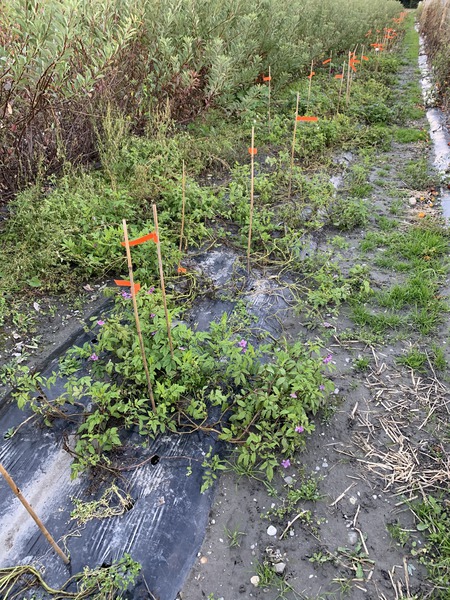

Pictures: different populations of potato seedlings; the clear differences in resistance can be seen (recording date: end of October)
How does Lubera now want to achieve something in potato breeding that even billionaire breeding companies cannot?
Yes, I'm a little surprised why, well over 150 years after the Irish and European famine, the famine caused by the potato Phytophthora, there are still hardly any reliably resistant varieties available on a broader scale. The reasons for this are manifold: of course, resistances have been broken again and again. But much more important and decisive for the somewhat poor resistance breeding results was the availability of efficient and relatively cheap chemical control agents against Late Blight, also known as Phytophthora. And finally, the most important reason is this: potato breeding companies do not breed for gardeners, nor for consumers, but for the demands of the processing industry. And resistance was and is not a priority there. Last but not least: even what the processing industry understands as quality has only a very limited relation to the quality for the consumer and for the gardener...
And how do we want to achieve the goals? By clearly prioritising them: firstly, resistance. Secondly, diversity, with varieties as different as possible in appearance, taste and colour – and thirdly, the quality of the taste. All of our future varieties must be resistant to Phytophthora, and at the very least, they must be either especially good and have a different taste or look. Ideally, they should differ positively in all three criteria from the well-known potato assortment. Other purely quantitative quality requirements such as yield or uniformity of the potatoes, eye depth and (within limits) starch content are secondary for us. By eliminating the requirements of the industry into our target horizon and looking only at the hobby grower, we make our breeding much more productive and the previously unattainable targets suddenly become attainable even if we apply the methods we have learned in other breeding programmes. Here, the potato breeding programme benefits not only from apple breeding, but also from outdoor tomato breeding, which has to fight the same natural enemies, Phytophthora and Alternaria.
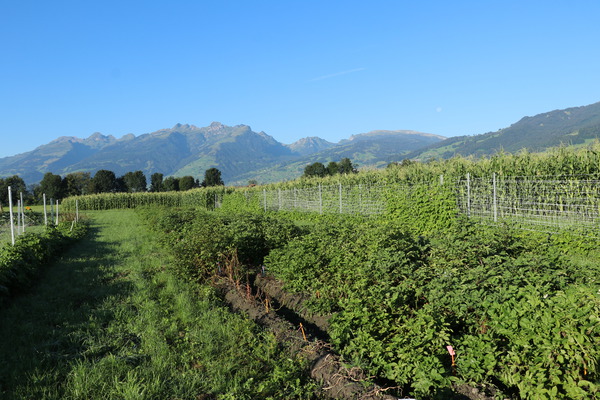
Picture: Selection field of the 2nd selection stage at the Rheinhof Agricultural School (Salez), taken in October; here, too, the resistant selection is clearly visible
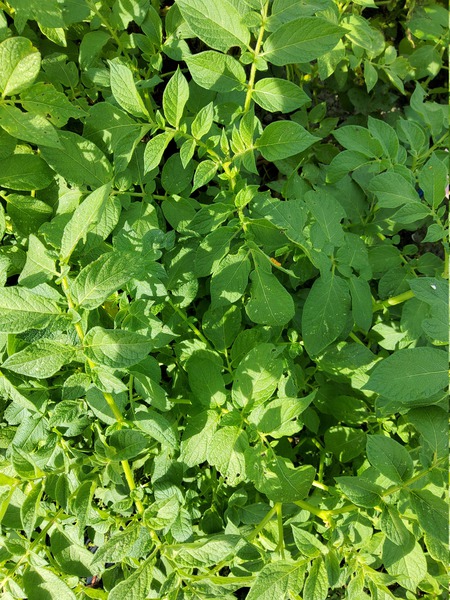
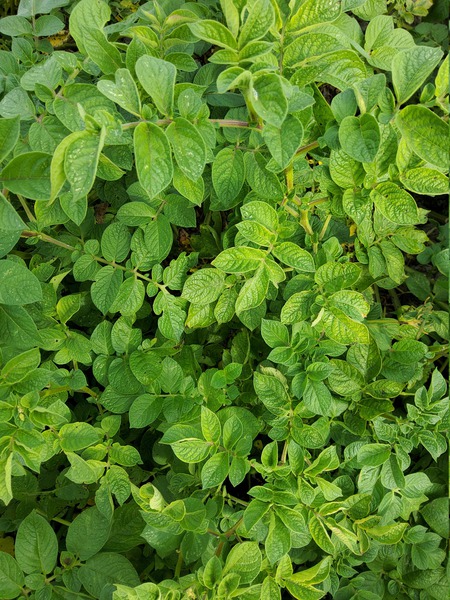
Pictures: Close-ups of the healthiest selections in mid-October
Is breeding for resistance at the expense of the potatoes’ taste?
No. On the contrary, we can also crossbreed resistance x taste and concentrate on this double goal because we can leave aside the ton mentality and the processing quality. It is the same breeding approach that we have used in all of our other breeding projects: we focus on the most important requirements of a plant's garden use, we prioritise the two to three most important goals and we forget for the moment everything else that seems important for commercial and modern agriculture. And lo and behold: by this detour, we breed varieties for many species that can become interesting again for agricultural niches.
How does Lubera breed potatoes and are F1 hybrids of potatoes also bred?
Hybrid breeding of potatoes is currently trendy; there are several large companies and generously financed start-ups that are trying to do this. The aim is to breed potato varieties as F1 hybrids that can then be propagated via seed and not via tubers. This would greatly reduce the costs of propagation and also facilitate cultivation in southern regions (the production and storage of potato seed tubers is very costly). F1 hybrid breeding, however, always means that diversity is lost quickly and, in our opinion, too quickly: inbred lines mean nothing more than the continuous exclusion of diversity! The whole breeding process in hybrid breeding is also very cumbersome and expensive, which itself works against diversity – only a limited number of inbred lines can be developed. Therefore we have deliberately decided against hybrid breeding because diversity, the widest possible range of shapes, colours, origins and tastes, is one of our three main goals.
Where do the genes for more resistance and also more diversity in potatoes come from?
We are actually pursuing two paths that we would like to finally bring together in a few years: on the one hand, we breed with the five resistance genes present in the Sarpo varieties (especially in Sarpo Mira) and try to incorporate these resistances into other varieties and breeding lines that tend to be close to the crop varieties. On the other hand, every year we test several thousand seedlings of various diploid and also tetraploid Solanum species for interesting tuber characteristics and also new resistances, which bring more diversity (and also other, still unknown sources of resistance) into breeding.
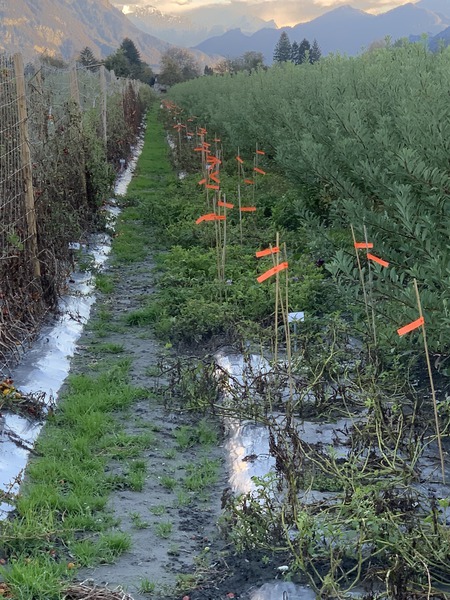
Picture: Field with seedling populations of different Solanum species
How far along is the Lubera potato breeding programme?
The breeding programme for cultivar-near, resistant varieties is already quite advanced. This year we had about 300 varieties in the level 2 test and about 30 clones showed absolute resistance to Alternaria and Phytophthora by mid-October. By the way, we also use markers for resistance selection and, above all, for the exact determination of the different types of resistance. On the other hand, we have made good progress in the selection of new diversity material this year: we have obtained breeding clones and parents from four Solanum species and have identified new sources of resistance in different populations, especially in diploid potatoes.
How long will it take until there are potatoes from Lubera?
In the best case, in three years we will be able to offer the first potato varieties from our own breeding; these will probably be more conventional varieties similar to the current cultivars, but with an absolute resistance to Alternaria and Phytophthora. But as always in breeding, we calculate and plan for longer periods of time: however, by 10 years it should be possible to put together a special and very specific home garden assortment with potatoes that will bring more colour, different shapes, sometimes even ornamental value and new flavours when growing potatoes in the garden.
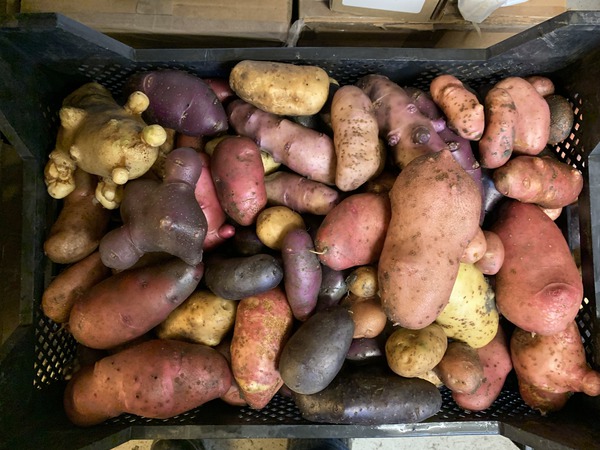
Picture: Variety of shapes and colours of the 2nd selection stage

Picture: The diversity of current potato breeding
How should these potatoes for the home garden be sold?
Here, too, we are thinking of new ways: we plan to offer our own potato varieties as in vitro propagated, small young plants. The consumer should not at some point (almost still in the winter) have to buy a half rotten seed potato treated with chemicals, but a vegetatively propagated young plant from tissue culture, which can be planted directly into a potato bed or container.
The advantages of potato young plants compared to seed potatoes
The advantages of potato plants propagated vegetatively via cuttings or tissue culture are manifold:
- Extremely high health status, approx. 4-5 levels above conventional seed potatoes. This also means that there is much less infestation with viruses and other germs.
- Potatoes are planted when spring starts, not earlier.
- Better scheduling of the potato crop becomes possible. Especially late sets of potatoes in the home garden become interesting, which was almost impossible with conventional varieties and seed potatoes: resistant young plants can also be planted in July and harvested before Christmas.
- It becomes possible to plant many more varieties in a small garden in a very small space: it is not necessary to buy 10, 20, or 30 seed potatoes per variety.
- Propagation via cuttings and tissue culture makes the development of new home garden and niche varieties possible because maintaining the necessary health status for niche varieties is far too complicated and costly for conventional seed potato production.
